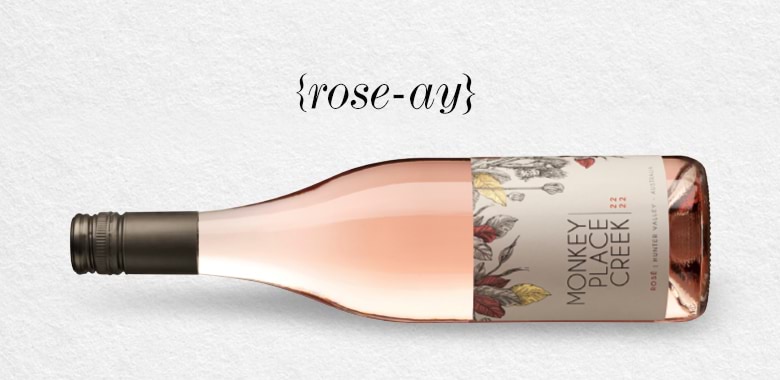
Wine
What is Rosé?
A summer staple and a mainstay in France for centuries, Rosé is a great partner to a wide range of foods. Perfect for alfresco dinners, backyard barbeques, and long lunches, its versatility also ensures it’s an ideal wine year-round. So what is Rosé, and why is it so popular? Is it a white wine or a red wine? How does it get its pink colour? Let’s dive in and discover the facts about this delicious pink drink.
Shop Rose
Rose Wine Infographic
WHAT IS ROSÉ
Versatile, refreshing and absolutely delicious, there is so much to love about Rosé! The popularity of this gorgeous, blush-coloured wine has soared here in Australia, and it’s easy to understand why.
A style of wine rather than a variety, Rosé, has come a long way since those sickly-sweet wines of the past to emerge as an anytime, anywhere, food-friendly treat. Australian Rosé is now decidedly dry, savoury and textural and its easy-drinking nature makes it a perfect match to our laidback lifestyle.
Neither red nor white, Rosé is essentially a pink wine made from red grapes, with minimal skin contact, in the style of a white wine. Many different varieties of red grapes can be used to make Rosé, so no two wines taste the same. Some of the most common varieties used are Shiraz, Pinot Noir and Grenache. Rosé can be made with a single variety, though it is often a blend of multiple varieties.
Rosé’s charming pink hue comes from grape skin contact with the wine for a short period of time – the longer the contact, the deeper pink the colour. Like most white wines, Rosés are best served chilled.
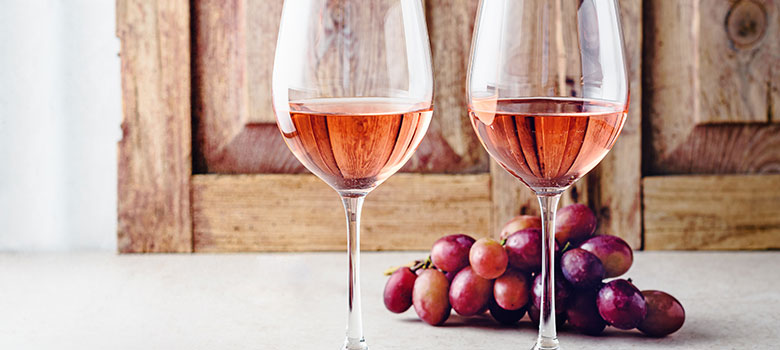
WHERE IS ROSÉ FROM?
The production and consumption of Rosé dates back to the Phoenicians and Ancient Greeks over 2000 years ago. In the ancient world, wine was made by crushing red and white wines together. Even when the colours were eventually separated, the harsh tannins in the reds saw many still preferring lighter coloured wines – the first form of Rosé!
Fast forward to 19th century Southern France and Rosé was seen as a casual drink to quench one’s thirst, with any tourist with half a fashion sense sipping it after a warm day at the beach.
In the mid-20th century, sweeter styles like Mateus from Portugal gave Rosé a reputation for being sickly sweet. Thankfully, the winemakers of today have refined Rosé, and in Australia it’s made in a mouth-wateringly dry style that’s a wonderful food match.
In some regions, like Provence in France, Rosé is a far more popular summer wine style than white wine.
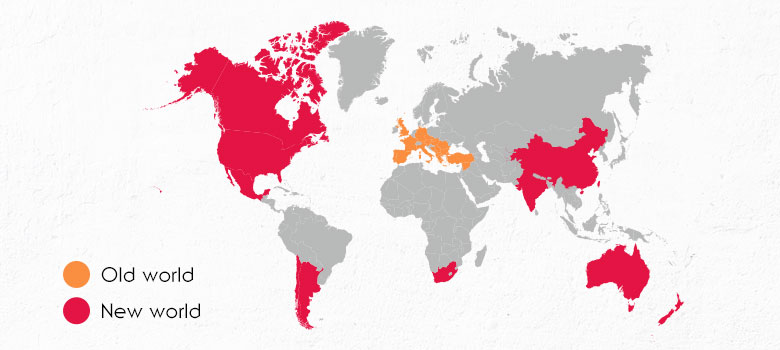
ROSÉ IN AUSTRALIA
Rosé’s flourishing reputation and suitability to match the Australian climate make it an ideal choice for wine lovers and a perfect alternative to a chilled white or a lighter bodied red. It also provides a great segue from drinking whites and moving into reds.
“Up until a few years ago, Australian winemakers made Rosé as an after-thought,” says Wine Selectors Tasting Panel Co-Chair Adam Walls. “Whereas now, the wines are being made deliberately, with designated parcels of fruit that have been picked specifically to be turned into Rosé.”
Australia is producing some absolutely top-notch Rosés that give the European drops a run for their money. Today, Aussie winemakers are experimenting with different techniques and grape varieties in order to make more complex and multi-layered Rosés. Leanne and Steve Webber at De Bortoli are widely considered to be responsible for starting the trend for dry, lighter-coloured styles of Rosé here.
According to Russell Gallagher of award-winning Serafino Wines, Australian winemakers have listened to consumer demands and are now ‘on trend’ with the styles being produced. “Consumers are looking for that ‘Provence’ style, which is pale pink or rose gold in appearance, and fermented to dryness while displaying minerality and subtle fresh fruit sweetness.”
Many factors influence the final product, including the variety or varieties used and environmental factors. “For our Gold medal-winning Serafino Goose Island Rosé 2021, we turned up the volume and experimented with Montepulciano and Grenache. For these later ripening varieties, we need the Summer to keep rolling on into late March so these grapes can reach their full flavour potential”, explains Gallagher.
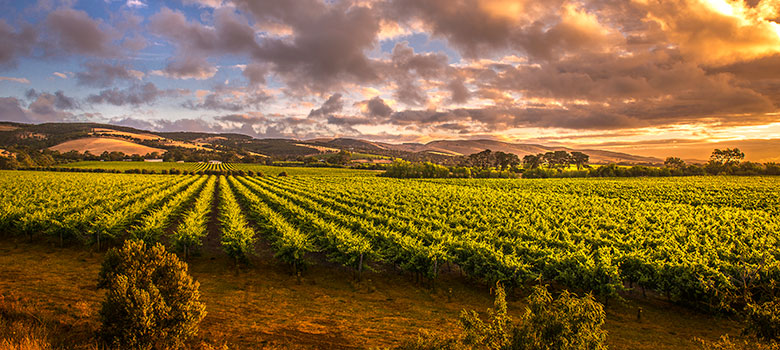
BEST ROSÉ REGIONS IN AUSTRALIA
As Rosé is a style and not a varietal, it’s able to be made in all regions throughout Australia using many different varieties such as Pinot Noir, Grenache and Shiraz. With its popularity on the increase, Rosé is no longer an afterthought, but a style that many winemakers focus on as part of their stable.
In Europe, the regions the span the Mediterranean have the strongest reputation for Rosé production. We are lucky that a number of the key, heat-loving varieties used in Europe thrive in the climates of the Barossa Valley and McLaren Vale. Grenache is the major player, with both regions having enviable vineyard holdings. Other varieties such as Carignan, Cinsault and Mourvèdre (Mataro) play a supporting role. Expect the wines to be pale in colour, dry and savoury, with tannins giving the wines extra depth and texture.
Western Australia has an enviable ability for producing outstanding examples of all styles of wines and Rosé is no exception. The wines echo the modern-day trend of being lighter in colour, dry and savoury, with mouth-watering acidity. Cabernet Sauvignon and Shiraz are the traditional varieties used, but these days you can find superb wines made from a wide range of single varieties and blends.
A cool and long-growing climate allows for the production of high-quality Rosé. Pinot Noir and Cabernet Sauvignon are two of the Yarra’s hallmark red varieties, and these are utilised for Rosé production along with a suite of other varieties including Pinot Gris, Pinot Meunier and Nebbiolo. The wines are light bodied but full of energy, with acidity and tannin playing important roles. Winemaking influence like lees aging and oak use can add extra dimension.
A cool climate and a vast number of vineyard elevations and aspects means the Adelaide Hills can produce a vast number of red varieties. Pinot Noir is the most common variety used for Rosé. The wines are lighter bodied, aromatic and have a seductive silken texture. The past decade has seen an explosion of new wave red varieties planted, and these are being used for Rosé production as well. Expect these wines to be light in colour with high acidity and savoury tannins.
Mudgee’s growing conditions are well suited to traditional Rosé varieties as well as alternate Italian varieties. Expect Mudgee Rosés to be pale in colour, dry and savoury. The best ones will showcase the flavours and characters of the variety or varieties it is made from.
WHAT DOES ROSÉ TASTE LIKE?
From dry to sweet and everything in between, there’s a Rosé to suit every palate. Given how many different varieties can be used to make Rosé, no two wines taste the same. While most Australian Rosé is made in a dry style, there are off-dry and sweeter examples. However, they’re usually made in the same way, with the biggest differences being variety, where it comes from, residual sugar and alcohol level.
Pinot Noir-based Rosé can be depended on to deliver good quality with soft, easy characteristics of plums, spice and an array of savoury fruits. Sangiovese typically produces drier styles of Rosé, with savoury cherry flavours. Cabernet Rosés offer bright berry flavours, often with a leafy, herby edge. Grenache-based Rosé has emerged; these wines tend to be sweeter, fuller and offer a vast array of berry-based fruit flavours.
Some wine-lovers like to experience Rosé in the form of a delicious Frosé cocktail – ideal as a cool summer treat.
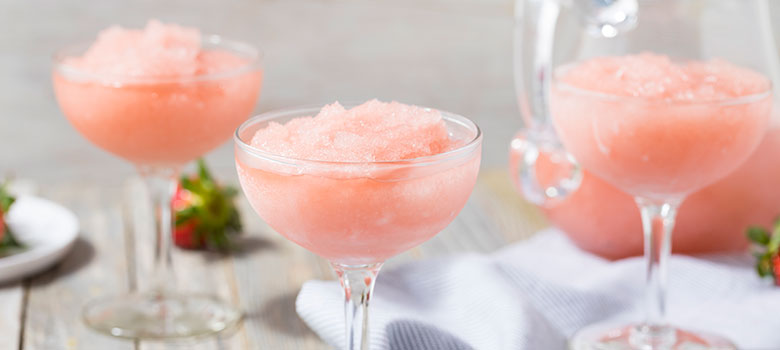
HOW IS ROSÉ MADE?
Rosé can be made from just about any red wine grape variety there is. In Australia, the more common varietals used to make Rosé include Shiraz, Pinot Noir, and Grenache, but Merlot and Cabernet Sauvignon are also used regularly. In Provence, the historical home of Rosé, winemakers will blend grape varieties, such as Cinsault, Mourvédre, Syrah (Shiraz), and Carignan, to create gorgeous examples of this pale pink wine.
Just like red wine, Rosés pick up their colour from the skin of red wine grapes. The crushed skins of the red wine are left in contact with the grape juice for a short period of time, typically anywhere from 2 to 24 hours – the shorter the time, the lighter the colour. Once the desired colour is achieved, the skins are removed and the juice is fermented into Rosé. This is known as the maceration method.
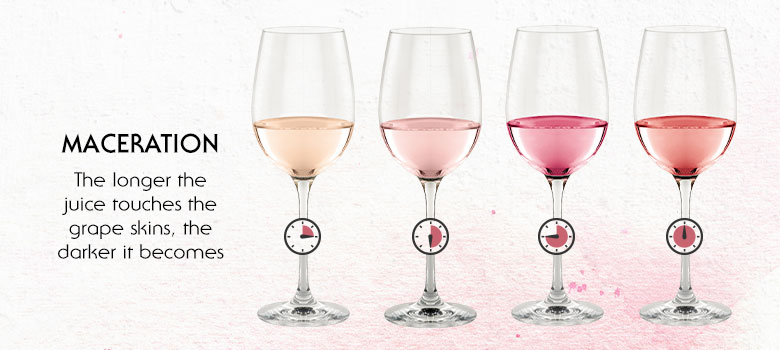
To learn more about how Rosé is made, including alternate methods used and expert winemaker observations, check out our Rosé revealed article.
COLOUR AND CHARACTERS:
The colour of Rosé can range from the lightest shades of pale onion skin pink to salmon, coral, hot pink, and ruby red; generally speaking, the darker the colour, the more intense and sweeter the wine. Primary fragrances and flavours of Rosé depend on the type of grape, or grapes, used, but will typically sit along the spectrum of red fruits and florals, melons and zesty citrus. Sometimes, you’ll find pleasant green characters, like rhubarb or strawberries with their leafy green tops still on.
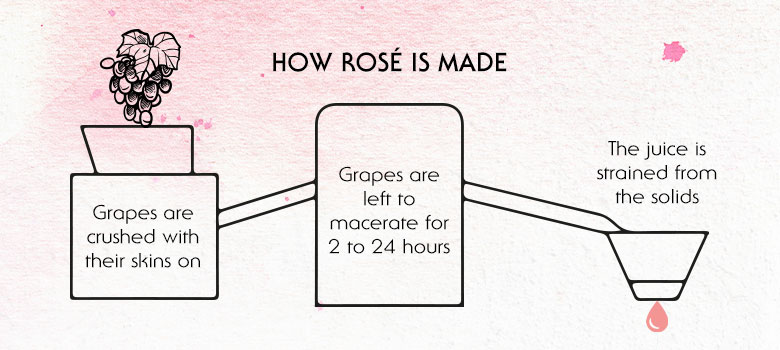
SHOULD I CELLAR ROSÉ?
A bonus about this joyous drop is that Rosé is a ‘drink now’ style and doesn’t need to be cellared. That means there is no wait time and you can enjoy these blushing beauties soon after release.
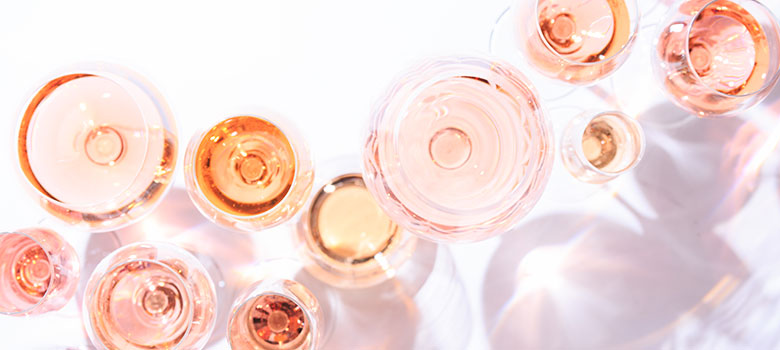
BEST FOOD PAIRINGS FOR ROSÉ
From brunch and lunch to dinner and dessert, Rosé has every situation covered. Incredibly versatile, it pairs with a vast range of food styles and dishes including fresh salads, seafood, charcuterie platters, tapas, steak, and spicy foods. And don’t forget desserts – sweet and sparkling Rosé’s are great with light, fruity desserts. Yum!
Have we made you hungry? Why not check out some of the foods and dishes that are ideal pairings with this popular pink drop.
Pairing wine with Entrees
Pairing wine and Thai